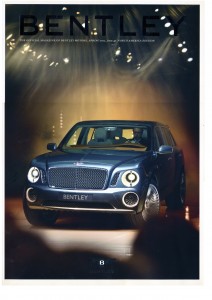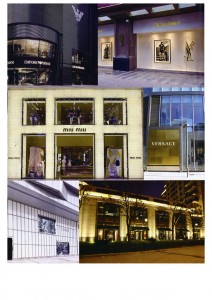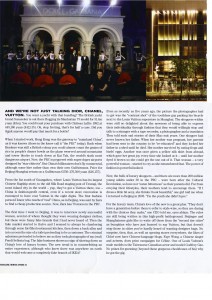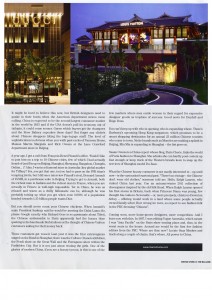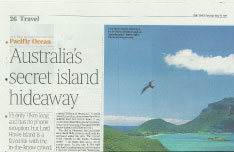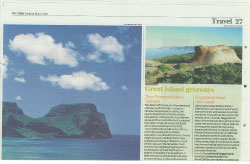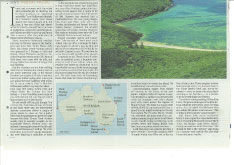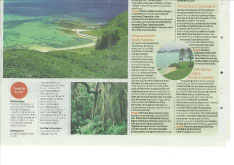Category Archives: Travel
Australia’s Secret Island Hideaway – The Times
Australia’s Secret Island Hideaway
The Times | Sunday 12th May
It’s only 11km long and has no phone reception, but Lord Howe Island is a favourite with the in-the-know crowd, says Marion Hume
I once met a woman with the weird and wonderful job of checking out far-flung locations for “vacational suitability” for a Hollywood clientele. So I shared a secret: Lord Howe Island. She hadn’t heard of it, but then, it was one of the last islands on Earth to be discovered. It bears no trace of indigenous settlement and Europeans and Polynesians didn’t show up until more than a century after the publication of Daniel Defoe’s Robinson Crusoe.
Savvy Aussies-in-Hollywood certainly slip away to this tiny speck in the Pacific, governed from New South Wales. Judy Davis, the Emmy award-winning actress who appeared in A Passage to India and Woody Allen’s Husbands and Wives, has visited its golden sands, as has Eric Bana of Hulk fame, who came with his kids, and George Miller, the director of Happy Feet and Mad Max.
But the islanders are too busy milking their cows or minding their honey bees to pay much attention and, as for visitors (numbers are capped at 394 at a time), why would you bother ogling stars when you can spend the time paddling with exotic fish in more colours than a Matthew Williamson Kaftan? Anyway, the island – 11km long (6.8 miles), 2.8km wide and 770 km across the Tasman Sea from Sydney – is out of mobile phone range, so you can’t call and tell your friends which famous name you’ve just spotted.
It’s not totally off the grid, though. You can buy the Australian edition of Grazia at the local store and an intermittent internet connection allows a couple of young mums to shop on Net-a-Porter (then wait for purchases to arrive by barge because the daily 32-seat Das 8 plane usually flies at capacity weight). As for fashionable visitors, Stephen Jones, the milliner, is among devotees of what he calls “an unspoilt hideaway”, adding: “In a few short days, Lord Howe’s magic transports me, even inspiring a collection of mine entitled ‘Drifting & Dreaming’.” A gentle respect pervades a place where the school uniform does not include shoes. If you need to move faster than you can walk bare-foot, you hire a bicycle. (The speed limit for the few dozen cars is 25km an hour.)
The chef at Pinetrees, the local hotel since about 1848, cycles to work with his surf board under his arm. The relaxed mood extends to the hotel’s “business centre” – an empty desk and a can of mozzie spray. No one uses it. The staff joke that they place bets on how few hours it takes guests to go from “boardroom to BBQ”.
“A few people do ask where the lap-pool is. I say ‘over there, mate’.” says Luke Hanson, one of the Pinetrees’ proprietors, gesturing to the lagoon that is home to 90 species of coral and more than 500 species of fish. Hanson has married into a matriarchal clan. His two young daughters, Elsie and Pixie, with wife Dani Rourke, an islander and former hot-shot Sydney lawyer, represent the seventh generation of women running Pinetrees (for, make no mistake, three-year-old Elsie definitely thinks she is running the place).
There’s abundant nature and history here. Take the tale of Dani’s great uncle Albert, who ran off as a teenager, by lighting a beacon to attract a passing ship and said he’d been shipwrecked. Eventually he settled in England, where 30 years later, he wrote home to tell the folks his new job – boatswain on the Titanic. Some 50 years after he perished at sea, s daughter traveled to Lord Howe Island, where she recalled her father as delusional; full of improbable stories of birds balancing eggs on branches instead of building nests and flocks swooping from the sky at a human call. It’s such true facts of fascinating fauna that made Sir David Attenborough breathless when he vanished to the island. He described it as “almost unbelievable”.
Accommodation ranges from simple self-catering to the luxury of the new duplex Lidbird Suite at Capella Lodge, which features a bathtub on a private deck under the frangipani trees and a plunge pool with views across the lagoon to Mount Gower. The latter is a tough climb of 875m (2,870ft), so a more sensible way to spend the day might be lazing on the day bed reading The Freudian Slip by Marion von Adlerstein, the must-read of the Australian summer, in part set on Lord Howe. Lovely Capella lodge is child-free, so its owners, James and Hayley Baillie, who have four young boys, stay at Pinetrees.
Lord Howe isn’t an island to jam into a tight schedule. There ‘s the voyage to Ball’s Pyramid, which rises 551m out of the sea life a Gothic spire. There are glass – bottom boat trips that are far less frenzied than on the Great Barrier Reef, and not-to-be-missed – even by those who think bird-watching is for twitchers – is a ramble with the ornithologist Ian Hutton.
Then there is doing nothing. When Kris Lewis, the general manager of Arajilla Re-treat, returned after seven years working across Asia, he asked the fisherman who also refuels the planes what was new. “The windsock at the airport,” came the reply.
Still, there’s been much excitement lately. A new copper has reported for duty. Senior Constable McGrath’s correct title is “Lock Up Keeper Lord Howe Island”, though no one even locks their doors. The closest thing to that is the “privacy” sign hung on a banyan tree outside the yurt that houses the sap at Arajilla.
Radical Departures – Bentley Magazine
Radical Departures
Forget the cliches- it’s time to rediscover Australia
by Marion Hume
My theme is Australia. You may consider this southern continent the most radical departure from everyday experience- or equally, the least. It is, of course, a long way from just about everywhere and spending your entire weekend traveling may be a strange notion (except those who commute from London to Sydney.) Yet it is also the faraway destination that you might think holds little to surprise. We know all about Bondi Beach and finding Nemo on The Great Barrier Reef and that vast red rock in teh centre correctly called Uluru, don’t we?
Yet Australia is travel’s big surprise for 2012 in terms of culture, food and travel experiences which which have zero to do with the old ‘flop and drop’ backpackers of old. Let’s consider food first. We know Australia is the land of fusion, the nation that exports hard-working chefs – ask to meet the creator of your dinner anywhere from Bruges to Beijing and chances are, the bloke who emerges from the kitchen has a lazy gin and an Aussie greeting. But what is so buzzy is the Sydney food scene. Melbourne and Adelaide have long been vibrant food centers, this in no small part sue to sophisticated emigres from Italy and Greece. But in Sydney, the equation used to be ‘great view + lackluster food + too chilly air con and bad service = huge bill’. Now, one of the city’s best restaurants is in a basement.
But lets us focus first on the entrepreneur and food god that is Maurice Terzini, who helms several restaurants with peerless views and great food. Terzini, with partners Robert Marchetti and Kimme Shaw, has changed Sydney. Icebergs Dining Room and Bar, with glittering views across the ocean at Bondi Beach, is one of the few restaurants on earth where it is a requirement, rather than a pose, to eat lunch in dark glasses. Then came North Bondi Italian Food, where the queue for tables starts at 6pm (no reservations). Now, in Neild Avenue, a road drivers used to cut through without stopping, comes the latest arrival, called- with brevity-Neild Avenue and housed in a former factory. What’s to love? The ambience, and the gorgeous Sydney women in high heels and tiny dresses? Yet, but thats common in this snazzy town. The difference is the food, which here features Ottoman cuisine as flavorsome as in those run-down shacks by the Bosporus. We’re talking lamb pistachio kebabs with cracked wheat and hung yogurt, velvety hummus, buffalo halumi with lemon, mint and shallot salad. Diners even get excited about cauliflower.
Sydney is not only Terzini’s town of course. Neil Perry (who creates the onboard catering for Qantas, surely the only long haul airline where you actually look forward to dinner) is the reigning monarch of Rockpool and its many spin-offs. His latest is the Spice Temple, where the food is fiery with the flavours of Sichuan, Yunnan and Xinjiang This is the joint in the basement so dinners enjoying a combination of fine local produce and authentic regional Chinese cuisine have nothing to divert them from what is on their plates. Then there are the little joints, like Vientiane, an organic Laotian restaurant combined with an art gallery which is carving out a name for “wellness” food that manages to be delicious and can be washed down with organic wine in a cute little boite hung with cutting-edge art. (Last time I was there, someone dropped AU$60 for dinner and AU$6,000 for a sculpture. Which was a shame because they had the latter packed to go while I was eating and I’d been enjoying the sight of it.)
Even home cooking has changed. The land of the “sausage sizzle ” has moved on from the humble ‘snag’ (which translates as ‘sausage’ from the local argo, ‘strine’). Fashionable in Sydney now? Competitive butchery with butchers shops as done up as the lobbies of small luxury hotels. Victor Churchill, in the Sydney suburb of Woollahra has a Himalayan salt-brick wall to help age the beef. In my grandmother’s day, shopping for supper meant asking if there were any chops. Now, customers can be heard requesting 36-month-old grass-fed meat, dry-aged for 30 days, for mince for burgers.
While butchers shops look like shiny hotel lobbies, the best hotels in Australia combine low key charm, the least possible impact on the environment and very good local wine. Southern Ocean Lodge is on Kangaroo Island, a short hop from Adelaide, South Australia. Hotelier James Baillie is a visionary, although you’d need at least 20:20 vision to even spot the lodge from afar as it disappears into the hillside . But there ‘s no swimming here. Although the ocean spray comes right through your window, out there is the No.1 breeding ground for the Great White Shark.
James Baillie has made it tricky for me to choose my No.1 hotel on earth because he helms my equal two. Lord Howe Island was one of the last places on earth to be inhabited (and only descendants of the original handful of families can build houses there today). (It was first sighted at the end of the 19th century when a freighter was blown off course). As a result, the wildlife has no fear. Clap your hands and birds come down from the sky to see what is going on. But I’m no David Attenborough. I want supreme yet low-key comfort with my ornithology Capella Lodge is perfect.
The greatest travel commentator of them all, Alan Wicker, used to say he liked his paradises slightly spoilt, which to me means no one for miles, but wine and a proper loo. Kuri Bay is way up in the Kimberley, on the remotest shore of one of the most isolated regions, known up to now only to pearl divers. In partnership with Paspaley Pearls, Wild Bush Luxury – helmed by CHarles Carlow – has transformed Australia’s oldest pearl farm into a five room homestead, which is not luxurious in the traditional sense yet guests enjoy rare local delicacies such as pearl meat. The property is only accessible by helicopter or sea plane – a spectacular, one hour and 45-minute air safari from Broome, itself a tiny tin-roofed town three hours flight north of Perth, in turn the most isolated city in the world. Just don;t pack the IPad.
Travel alone to Three Hummock Island, off the northwest coast of Tasmania and you will be increasing the resident population by 50%. There are two residents at the place on our planet which enjoys the purest air quality. THis isle is an ark, where you can see all manner of rare marsupials. This is new luxury, which is to say managers John and Beverly O’Brien do everything possible to ensure a lovely stay. Just don’t expect a lock on the loo. Or indeed, a closed door.
Come to Australia for the culture? In which other country might you do a three city hop where the most radical contemporary art- some of it so transgressive it is rarely exhibited elsewhere – will knock your socks off? Let’s start with Sydney’s Museum of Contemporary Art, reopening after an AU$53 million rebuild this spring to reveal galleries of a scale that would make London’s Tate Modern and Madrid’s Museo del Prado jealous. And they are already jealous, one presumes, of a location right across the harbour from the Opera House, itself the ultimate site-specific work of art.
The Queensland Gallery of Modern Art is up in steamy Brisbane where the mercury rises. Brisbane was a country town that has become a city (Chanel has opened a store there). The fashionable hatter, Stephen Jones, curated an exhibition called Hats, an Anthology, a work of whimsy which proved a suprise crowed pleaser at London’s V&A. When it travelled to Brisbane, 165,158 people saw it in 60 days- many of them many times over, given the population.
Small? What about Tasmania, where even the locals joke about people with two heads. (Before you criticize me for the preceding line, see the brochure for MONA- The Museum of Old and New Art – in Hobart, which announces that ‘Tasmanians (two heads etc.)’ may enter for free.)
MONA is the single most exciting art gallery to have opened anywhere since Frank Gehry’s Guggenheim at Bilbao. Sleepy Hobart is now in shock about how a native son – one David Walsh, who made his millions by developing a spread betting system for gambling on horse races- has opened a private museum, filled with his own treasures and largely funded by himself, and lured so many people to an extraordinary art space carved out of the rock and to which access is by boat.
Wim Delvoye is one of the world’s most controversial artists. He is best known for Cloaca, which replicates the process of the human intestine turning food to waste, and also for an art farm where piglets were tattooed then allowed to live for a decade, far longer than is conventional farming before their skins were displayed. Louis Vuitton and Disney are among those who have tried, unsuccessfully, to sue Delvoye for tattooing their logo’s on pigskin. MONA is the first gallery anywhere to show Delvoye’s complete exploration of religion, which includes dead mice acting out the stations of the cross and a real live man called Tim as a silent Christ-like work of art.
Australia as a radical departure? Surely yes, especially as this article does not even mention…sport.
The People’s Republic of Luxe – 10 Mag
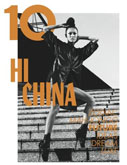
The People’s Republic of Luxe
10 Mag | Issue 41 November 2011
When I was a little girl, before you were born, China was the place they made cheap stuff. Now it’s the place where all the luxury labels have to have their snazziest stores in the world. When I was a teenager, China remained closed – they only let them out to scoop up all the medals at the Olympics. Now, of course, if you are in fashion, you have to go there to scoop up your share of an annual consumer expenditure estimated to top 1.3 trillion yuan (about £122 billion) by 2020.
by Marion Hume
And we’re not just talking Dior, Chanel, Vuitton. You want a yacht with that handbag? British yacht brand, Sunseeker is out there flogging its Manhattan 73 model for 31.4 million yuan (£3 million). You could toast your purchase with Chateau Lafite 1982 at 445,186 yuan (£42,115) Oh stop fretting, that’s for half a case. Did you think anyone would pay that much for a bottle?
When I started work, Hong Kong was the gateway to “Mainland China” as it was known (those in the know call it “the PRC” today). Back when Honkers was still a British colony, you could almost count the grains of rice in people’s dinner bowls as the plane swerved around mountains and tower blocks to touch down at Kai Tak, the world’s sixth most dangerous airport. Now, the PRC is peppered with super-dooper airports designed by “star-chitects”. But China’s billionaires don’t fly commercial, although some hire rather than own their own Gulfstreams. Price for Beijing-Shanghai return on a Gulfstream G550: 276,500 yuan (£26,157).
From the far south of Guangzhou, where Louis Vuitton has its largest Chinese flagship store, to the the old silk road staging post of Urumqi, the most inland city in the world – yup, they’ve got a Vuitton there too – China is fashion profit central, even if a recent store renovation is rumoured to have cost Vuitton in the eight digits. The first fashion person I knew who reached “real” China, as in Beijing, was sent by Zara to find a cheap production source. Now, Zara has 70 stores in the PRC.
The first time I went to Beijing, it was to interview newly-successful women, several of whom thought they were wearing designer clothes, but these were funny fake brands that I had never heard of. Then the fake market started to thrive and I seemed to always be clambering through some fat-filled restaurant kitchen, then down a back alley and into a room the size of a toilet pretending to be a customer. The criminal salesmen pretended to believe me as they took photographs of my (real) Fendi Selleria bag. The fake business shows no sign of slowing down as China’s love of luxury booms. The new trend is in counterfeiting an entire experience, although who knew there was anywhere on earth that they would welcome a completely fake branch of IKEA?
Even as recently as five years ago, the picture the photographer had to get was the “contrast shot” of the toothless guy parking his bicycle next to the Louis Vuitton superstore in Shanghai. The shoppers within were still so delighted in the newness of being able to express their individuality through fashion, that they would willingly stop and talk to a stranger with a tape recorder, a photographer and a translator. They told such sad stories of their Mao suit years. One shopper never knew her father. When her mother was pregnant, her parents had been sent to the country to be “re-educated” and they locked her father in a shed until he died. Her mother survived eating frogs and birds eggs. Another was once given a yellow silk shirt from abroad, which gave her great joy every time she looked at it – until her mother dyed it brown so she could get the use out of it. That woman – a very powerful woman – started to cry as she remembered that. The power of fashion is powerful indeed.
Now, the bulk of luxury shoppers – and there are more than 200 million young adults under 30 in the PRC – were born after The Cultural Revolution so have not “eaten bitterness” as their parents did. Far from envying their lifestyles, their mothers tend to encourage them. “If I dress a little bit sexy, she thinks I look beautiful,” one girl told me when I returned to Beijing in 2008. “I’m the youth she didn’t have.”
For the luxury tsars, China’s love of the new is a great plus. “They don’t have a generation before them to refer to style-wise, so they are daring with the choices they make,” one CEO told me, eyes ablaze. The rules are still being written in this high profit battle ground. Beijinger and Shanghainese girls like to write off those from the “second tier cities” as bumpkins who have just learned to say Vuitton, but that doesn’t stop those in cities you’ve hardly heard wanting designer bags. No surprise then that as well as opening stores everywhere, the likes of Chloe now have Chinese language blogs. Faye Wong, a Chinese singer and actress, does print campaigns for Céline. One of Louis Vuitton’s male models is Taiwanese-Canadian actor and model Godfrey Gao. No prizes for guessing (beyond those gorgeous cheekbones) why he got the gig.
It might be hard to believe this now, but British designers used to quake in their boots when the American department stores came calling. China is expected to be the second-largest consumer market in the world by 2015 and if the USA doesn’t pull its economy out of tailspin, it could come sooner. Guess which buyers get the champers and the Rose Bakery cupcakes these days? But forget any cliches about Chinese shoppers liking the logo-a-gogo stuff. The level of sophistication is obvious when you walk past racks of Vanessa Bruno, Maison Martin Margiela, Rick Owens at the Lane Crawford department store in Beijing.
A year ago, I got a call from Francois-Henri Pinault’s office. Would I like to join him on a trip to 10 Chinese cities, few of which I had actually heard of (and I’m up on Beijing, Shanghai, Shenyang, Hangzhou, Chengdu, Dalian…)? Alas, I was in a diamond mine in Australia (key global market for Tiffany? Yes, you got that one too) so had to pass on the PPR titan’s tempting invite, but I did once interview Pinault’s rival, Bernard Arnault of LVMH, in a penthouse suite in Beijing. Trying to get to Arnault, both the richest man in fashion and the richest man in France, when you are actually in France is well-nigh impossible. Yet in China, he was as relaxed and warm as a chilly billionaire can be, although he was probably totting up what you get when even 0.001% of a population headed towards 1.35 billion people wants Dior.
But you should never count your Chinese chickens. When Arnault’s mate President Sarkozy said he would be meeting the Dalai Lama (do, please Google exactly why Richard Gere is so passionate about Tibet), the Chinese ambassador in Paris apparently had the luxury titan quaking in his handmade Berlotti shoes at the thought of Chinese Vuitton customers asking for their money back.
Those customers get wooed. Last year it was the Dior extravaganza staged on the Bund in Shanghai; there was the “Culture Chanel” exhibition, the Fendi’s show on the Great Wall and the Ferragamo show within the Forbidden City. But it is not just about wooing the girls. One of the glories of modern China, if you are a luxury tycoon, is this is one of the few markets where men outdo women in their regard of expensive designer goods as trophies of success. Good news for Dunhill and Hugo Boss,
You can’t keep up with who is opening, who is expanding where. There’s Burberry’s upcoming Hong Kong megastore which promises to be a smart shopping destination for an annual 23 million Chinese tourists who come to town. Niche brands like Moncler are making a splash in Beijing, Miu Miu is expanding in Shanghai – the list goes on.
Susan Owens is a China expert whose blog, Paris Cherie, links the world of Paris fashion to Shanghai. She admits she can hardly post content up fast enough or keep track of the Western brands keen to snap up the services of Shanghai model, Du Juan.
What the Chinese luxury consumer is not madly interested in – up to now – is the vast nation’s sartorial past. “There’s no vintage—Chinese don’t wear old clothes,” someone told me. Hello Ralph Lauren, who visited China last year. Cue an autumn-winter 2011 collection of cheongsams inspired by the old silk road. When Ralph Lauren opened his first stores in Britain, back when Princess Diana was young, few thought his coals-to-Newcastle – or more precisely chintz-to-Downton Abbey -offering would work in a land where some people actually owned family silver. How wrong we were so expect to see fashion folk in the PCR dressing “Chinese”
Coming soon, more homegrown designers, more competition. And I leave you with this. In 1997, I was editing Vogue Australia, which meant I was “Asia Pacific” on the Paris show seating plans and thus in the worst seats in the house. Around me would be the first few fashion editors from the PRC. Where are they now? Locate Suzy Menkes and track along a couple of chairs, that’s where. All power to China.

